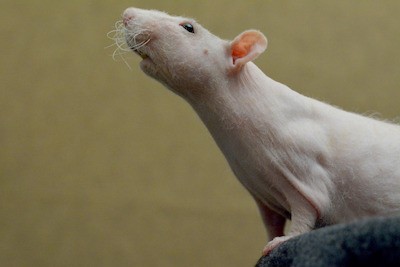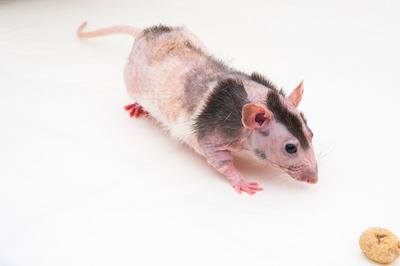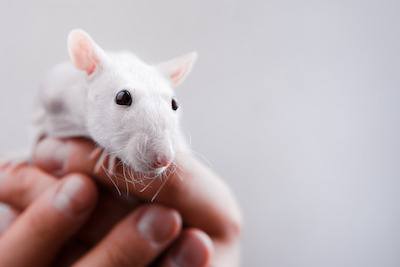If you’re like most people, you can spend hours looking at pictures of a cute hairless rat in sweaters, goggles, or speedos. Or maybe that’s just John Oliver.
Either way, furless rats are cute. But do they make good pets? Are they high maintenance? Do they smell foul? Are they smart or affectionate?
These are all questions you’re going to find answers for if you’ll read the article below.
Table of Contents
Types of Hairless Rats
Not all hairless rats are completely bald. Also known as Sphinx rats, these cuties are similar in features and nature to furred rats. Depending on the amount of fur and physical features, you can choose between the following varieties:
Double Rex

A Double Rex is one of the most usual varieties of furless rats you can find. They have no fur, but they sport some attractive curly whiskers. Some Double Rexes have tiny fur patches around their feet and on their faces.
Double Rexes come in different skin tones, and you can either choose a classic specimen with top ears, or one with side, Dumbo ears.
Patchwork Hairless

These cuties have Double Rex parents, whose genes combine to give Patchwork Hairless rats a blend of bald and curly furred spots.
You can expect their patches to fall, only to appear in another place every week. Don’t worry; this isn’t painful for your pet rat.
You can also choose the sin tone and ear shape that you find most appealing.
Truly Hairless

These bald rats really have no hair, including whiskers. Truly hairless rats are mostly used in science experiments because their incomplete thymuses create extremely weak immune systems.
These rats will develop all sorts of pulmonary, kidney, and liver infections. Their lifespans are almost three times as short as that of a healthy rat, so they can’t make very good pets either way.
Do Hairless Rats Need Special Care?
Caring for your hairless rats takes more work because the lack of fur means they’ll have difficulties warming themselves.
It’s not enough to up your room temperature, even though that alone can be a challenge if you live in a colder environment. You also need to adopt a second or third furless rat to keep your bald rat company and to keep him warm. The extra stimulation and activity from a partner in crime will also help your bald rat warm up. Up the room’s humidity levels because dry rooms cause skin problems in furless rats, such as abscesses and calcified wounds.
The extra hard work furless rats do to warm themselves entails a higher metabolism. The result is a higher need for more calories in their diets, so you need to consult with your vet and prepare a special meal plan for your little one.
The fur is a protective layer that keeps animals safe from irritations or toxic substances. Hairless rats lack this protection, so you have to be extra careful with the bedding and the general planning of their environment. Furless rats are more susceptible to wounds and chemicals, so they need soft, chemical-free bedding. Steer clear from pine or cedar shavings, which cause respiratory problems. Aquarium cages are best for bald rats because they have a reduced risk of accidental scratches.
Cleaning a furless rat requires regular washes, once every ten days. You can use mild, toxic-free baby shampoo with good results against buildup if you think that rat shampoos are too expensive.
Pro tip: Look out for any scabs or bleeding on your rat’s skin. If you notice trouble breathing, lack of appetite or runny stools, contact your vet immediately. Don’t worry if your pet rat feels warmer than a furred rat because that’s just his metabolism working at higher rates.
Otherwise, hairless rats require similar health and care as furred rats, such as:
- Plenty of toys and space to run around, hide, and dig
- Lots of restful sleep in a dark, cosy hideout
- Lots of love and attention
- A safe enclosure where other pets can’t get in
- Nutritious food composed from rat pellets and healthy treats of fruit and veggies
- Regular visits to the vet
Are Hairless Rats Good Pets?

Hairless rats are no less interesting, amusing, smart, or loyal than furred rats.
If you’ll get a hairless rat, you can expect extra affectionate moments because the little one will love cuddling in your arms for extra warmth. Your bald rat will like it when you rub his head, neck, years, and his back, especially around his tail.
Otherwise, you can expect a sensitive, empathic creature with a heightened ability to feel human emotions, according to various researches.
Rats are extremely intelligent and can be taught a lot of tricks. They’ll respond to their names, and you can teach your rat how to use the potty.
Bald rats like scavenging, hiding and playing. You can build burrows, obstacle courses, and play with a wide range of toys as long as they’re safe and don’t scratch your pet’s skin.
How Much Do Hairless Rats Live For?
The average lifespan of a furred rat is around 21 months, but some rats live to three years old.
Hairless rats have a shorter life expectancy, up to one year, because they’re more prone to diseases and infections. However, you can prolong your rat’s life expectancy if you take good care of him and visit the vet regularly to keep and diseases in check.
Do Hairless Rats Smell as Bad as Other Rats?
Rats don’t smell, so hairless rats shouldn’t smell either. Some people can notice a particular rat whiff, but that’s mostly the musky male odour.
If your bald rat starts developing a specific smell, check if the cage is clean enough. Sometimes rats will hide food that goes bad in their cages, which can trigger the bad smell.
If you don’t find anything wrong with the cage’s cleanliness, extremely foul smell is a sign of infection, and your rat needs a medical consult immediately.
Wrap Up
Bald rats have a unique cuteness caused by their lack of fur. However, they are more predisposed to a variety of illnesses and accidents, and they’re higher maintenance than a furred rat.
While extra maintenance, higher costs, and shorter lifespans are definite cons, hairless rats are cute, loveable, and extremely smart. Your bald rat needs the same amount of love and play as a furred rat, so he’s lucky to be adopted by someone who’s so interested in creating the perfect home for him!
